Santa Cruz
SantaCruz (Originalregel)
Before the start of the game
With /join 2 - 4 players can enter the game. With /start the game begins. Alternatively, you can use the game management use.
The game
Santa Cruz is a strategic discovery game with easy entry and high replay appeal.
Players explore a newly discovered island, colonise it and try to score as many points for themselves with the help of the score cards without having to take part in the scores.
This rule mainly provides instructions for online games. For deeper or special questions, the original instructions can be used, which on the publishing page is pdf can be downloaded.
Field
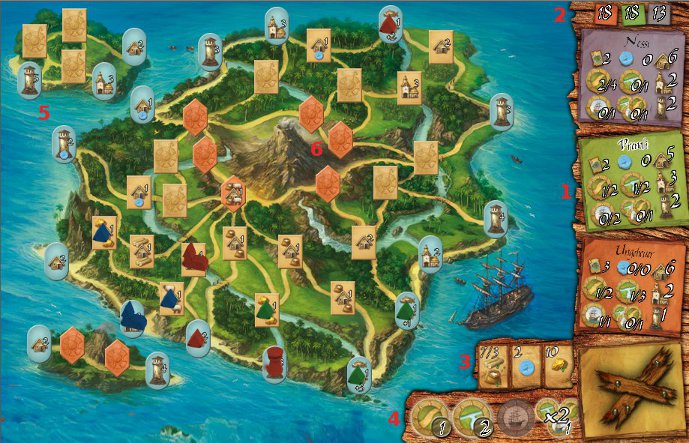
- Player display
- Points
- Own value cards
- Overview Handcards (travel cards, river maps, sea charts, double train)
- Coastal fields (blue)
- Volcanic fields (orange)
The name of the current player will always be displayed in white bordered.
Player display:
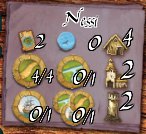
In the top row the not yet played cards are displayed on the left (2). On the right, besides the number of collected leaflets (0).
The right column shows the number of buildings still available (houses, churches, lighthouses)
The round platelets show how many construction cards a player has. The right number specifies the building cards of the set chosen at the beginning (that is, which cards the player has available for this round), the left number indicates which cards have already been played.
In the example, Nessi has already played four out of four maps. It has a river map, a ship map and a double-string map - all not yet played.
Player display alternative view:
If you pass the mouse over the player display, you will get an alternative view with an overview of the attributes collected by the player.
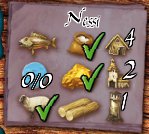
The attributes with a green hook were already collected by the player (here: sugar, gold, sheep).
Game sequence
The game runs over two rounds. In the preparation phase, all players receive their score cards and then reihum may choose a building card set.
Then the first pass begins in which all players reihum play their cards. When all cards are played, the second passage begins. All players may choose a set again, receive a new score card and place a score card again. Thereafter, the procedure is as in the first passage. At the end of the second round, the collected bird chips are evaluated, then the game ends.
Preparation
All players receive eight houses, three churches and two lighthouses to build. Of the 16 credit cards, which are distributed as follows: For 2/3/4 players, each player receives 4/3/2 credit cards.
The construction cards are divided into four sets:
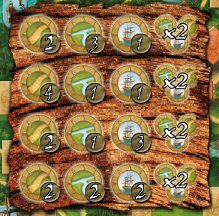
Each set contains a total of six construction cards in different weights for road, river or ship, as well as a double train map.
Once the game is started, each player may choose one of the sets. The last player in the train order may start, the starter must last choose. Tip: Before you select, you should take your score cards in your eye and choose your kits carefully!
In order to compensate for the starter's advantage, players will receive reihum 1/2/3 win points behind the starter as "Starthilfe".
1. Transit
Each player now determines, starting with the starter, reihum its starting position. Any free coastal platelet (blue) can be selected as the starting point. Possible construction fields are always marked with a flag.
Then the main phase of the game begins: The players put one of their cards on reihum. This can be both a construction map and a valuation map. To do this, you drive with the mouse over the score card view (3) and thus see all hand cards.
Construction
To build, you have to play one of his construction cards. Each card type allows only certain construction sites:
Ship cards:

Only the coastal areas (blue) can be built with a ship map. Click on a ship map, see all possible construction sites and then click on the construction site you want to build.
Maps:

If a player plays a way map, he must choose a building site that is already existing by way of a building direct to be reached.
Example:
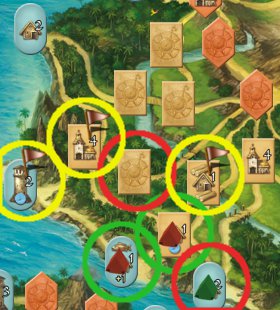
Red has already built two buildings (green bordered). The yellow bordered fields are likely to be used as they are directly adjacent to one of the two red buildings. The lower, red bordered field is already occupied by greenery, the upper is not directly accessible.
River maps:

In order to play a river map (sensual), a player must already be represented with any building on a river. If he now plays a river map, all the free spaces along this river are available to him.
Example:
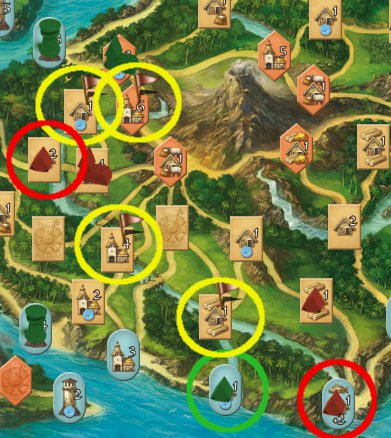
Green has already built a house at the bottom of one of the two river mouths (green bordered). On this river, it can now use one of the paved free construction sites (yellow bordered). He is not allowed to use the red-edged places because players have already built red there.
Double pull card:

With the double card you can make two trains one after the other. You have to select one of the three types of construction (way, ship, river); this then applies both Trains.

To use the double pull, click the double card. The three symbols appear for the three types of construction cards and you click on the desired type. Then two buildings are set according to the above rules.
In principle:
- The corresponding building type must of course still be available in stock to be built
- The printed point number of a building platelet is credited to the player directly on the point account
- As soon as a platelet has been built, all platelets directly adjacent to it (path or river) are exposed
- It may be placed on both open and concealed plates. A hidden plate is turned around. If the player does not have the required building type, his train ends with this
- There is train force: If a player can set up a building, he must also do it
- A card can also be played if no buildings can be set: In this case, the card is stored without action
In order to avoid a senseless playout, a security query appears if a card is to be played which does not allow any construction action.

If you don't want to play the card, you chose the red X. If you want to play it out and you want to throw the card without action, you choose the green hook.
Basically, it is forbidden to build on already occupied construction fields. Exception: The player who is last in the player order in the current passage may: single in the current passage on an occupied plate.
Values
Instead of a building card, one can also play one of its valuing cards. Value cards always apply to All Players!






If a player plays out one of these score cards, all players who have built at least once on such a raw material field will receive the printed score. Multiple building on the same raw material field increases the score not!
Example: If a player plays the gold card 6, all players who sit on a gold field with at least one building will receive 6 points.


If a player plays out one of these cards, all players will receive at least once both have built raw material fields, 7 points. Players who have occupied only one of the two raw material fields will receive 3 points.
Fish bonus:

There is an extra fish bonus for the fish. Every time a score card is played with fish, all players receive for each cultivated fish platelets the bonus points printed down there. Thus, in contrast to the effect of the actual evaluation card, a plurality of platelets are summed.
Example:
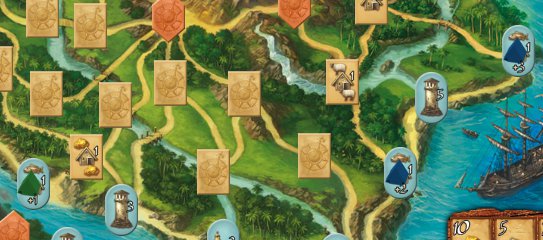
A player chooses the fish bonus card 5. Now both blue and green get the 5 points as both at least one Fish platelets occupied. Green also gets +1 bonus points for its platelet, blue gets +5 (+2 and +3) for its two platelets. Green thus gets a total of six bonus points through the fish card, blue gets a total of 10 points.

If a player plays this score card, all players who have built each building type at least once will receive 6 points.

If a player plays this score card, all players who have built at least four houses will receive 6 points.

If a player plays this score card, all players will receive at least four contiguous Building, 6 points. The buildings have to Ways be directly connected to each other!

If a player plays this score card, all players will receive 3 points for each building on a river. The buildings must not to be connected.

If a player plays this score card, all players will receive 3 points for each building on a (blue) coastal platelet.

If a player plays this score card, all players will receive 2 points for each bird chip they have collected.
Attention: Here is only the Number the bird chips, not their value! The value of the bird chips only enters the score at the end of the game (see below).

If a player plays this score card, all players will receive 3 points for each building on a (orange) volcanic platelet.

If a player plays this score card, all players will receive for each building on a (orange) volcanic platelet per -2 points.
If this card is played out, all buildings on Vulcan platelets are taken from the schedule and are no longer available in this passage. For the next passage they come back to the stock of their players. The now free volcanic platelets can be built.
Two. Transit
Each player gets back all his buildings back to his stock (also those destroyed by volcano).
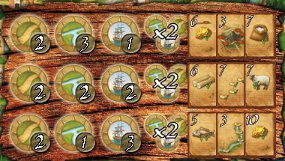
Now each player may choose reihum, starting from the rear, one of the sets from the first pass. In addition, each player gets a new value card hidden. From all the credit cards on his hand, he puts a covert back.
The second passage now runs exactly the same as the first one.
Playing
If all cards were played in the second pass, the gamer approaches. Now the points of the collected bird chips are added to the overall result. Who now has most points wins the game.

